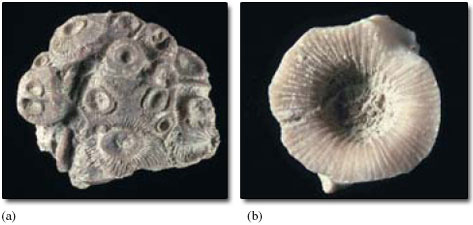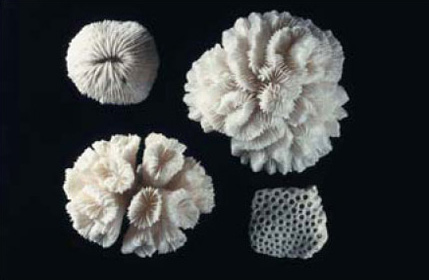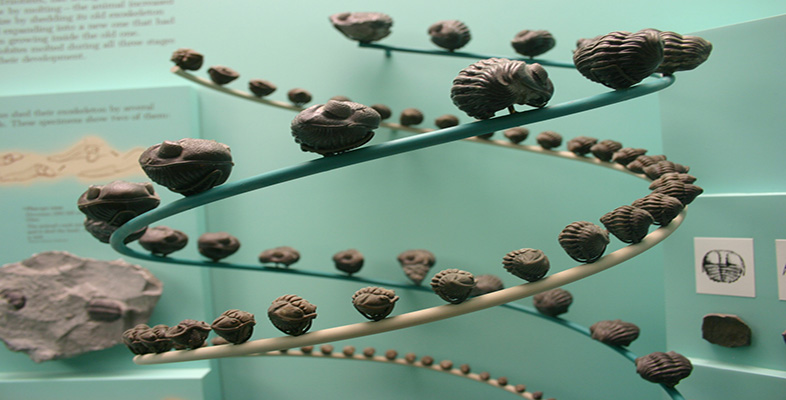4.3 Corals
Corals are especially abundant in the Wenlock Limestone.
SAQ 12
According to Section 1.3, which two main groups of corals, each confined to the Palaeozoic Era, might you expect to find in the Silurian Period?
Answer
Rugose corals and tabulate corals.
SAQ 13
Which of these two coral groups only forms colonies?
Answer
The tabulate corals are always colonial (whereas the rugose corals may be either colonial or solitary).
Figure 9 shows two rugose corals. When alive, the Acervularia colony in Figure 9a would probably have looked like a bunch of sea anemones, with each of them sitting in one of the bowl-shaped hollows of their calcite skeletons. The skeleton secreted by an individual, whether part of a colony or not, is called a corallite. In rugose corals, each corallite is usually divided by a series of conspicuous radial partitions, called septa (Figure 9). The corallites in a colony such as Acervularia share adjacent walls. In the centre of many corallites of Acervularia is a single, bowl-shaped hollow. Within some corallites there are one or more smaller hollows. These little hollows have the same basic arrangement of septa as in the larger corallites: they represent new individuals formed by the splitting up of their parent, enabling the coral colony to grow upward and outward by a process of asexual reproduction.

Tabulate corals are distinguished by having much smaller corallites than those of rugose corals, and septa are either absent or short and inconspicuous. Tabulate coral colonies may take various forms, including massive (Figure 10a) or chains (Figure 10b).
Some Wenlock Limestone corals are shown on pp.74 and 75 of the Atlas; see if you can distinguish the solitary corals from colonial ones. The coral at the bottom of the group on p. 75 is a tabulate coral called Heliolites.
SAQ 14
What sort of environments do corals tend to be associated with today?
Answer
Images of Australia's Great Barrier Reef and tropical islands like the Bahamas probably spring to mind (though not all corals live in shallow waters).
SAQ 15
According to Section 1.3, what is the main group of modern corals, and what is their age range?
Answer
Scleractinian corals; Triassic to Recent.
Figure 11 shows some examples of modern coral skeletons, both solitary and colonial. Like rugose corals, scleractinians usually have conspicuous septa. However, unlike both rugose and tabulate corals, the skeleton of scleractinians is made of aragonite, not calcite. Although it is also a form of calcium carbonate, aragonite tends to alter to calcite or dissolve away, so that Mesozoic and Cenozoic corals (i.e. scleractinians) are often less well preserved than Palaeozoic ones.
Most, but not all, scleractinian corals today grow in warm, clear, shallow seas. The same seems to have been true of many ancient corals, including Palaeozoic ones. The requirement of many of today's corals for clear, shallow water is mostly because within the corals' soft tissues are tiny algae with which they live in an association of mutual benefit. The algae require clear, well-lit water for photosynthesis. By analogy with the preferences of most modern corals, and what is known of ancient ones, it therefore seems very likely that the water of the Wenlock Limestone sea was warm rather than cold. This is supported by palaeomagnetic evidence showing that at this time Britain was about 25° south of the Equator. Palaeozoic and scleractinian corals are, however, unrelated and there is evidence that Palaeozoic corals lacked a special association with algae.


